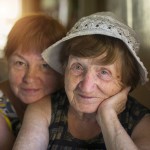
Caring for older people is already one of the main functions of a care system, and will increasingly become more important as the population ages. Estimates from the King’s Fund (2012), suggest the numbers of people aged 85 and over will double by 2032. Consequently, family carers are likely to play an increasing role in providing care, as public funds contract, reducing the availability and quality of formal care services
Haberken et al’s (2015) article centres on the fact that women provide much more care than men, which is supported by much evidence. However they note a difference in the percentages of care provided by family members in different countries of Europe, with 80% of care being provided by relatives, compared with 40% in Denmark.
Three theoretical ‘causes’ of this inequality are proposed:
- Daughters and sons may have different resources and needs that affect their care-giving, e.g. education, employment status, etc.
- Daughters and sons may respond to the same needs and resources in different ways, e.g. daughters may be more responsive to their parents’ needs.
- Welfare state regulations and cultural norms may not be gender neutral and could affect the engagement of daughters and sons in intergenerational care differently.
The authors propose what they call the ‘intergenerational solidarity’ model, in which solidarity between generations is affected by resources and needs of parents and children (at an individual level) and family structures at a family level and by ‘cultural-contextual structures’ (e.g. welfare and tax regimes) at a societal level.
The article is an attempt empirically to explore these aspects, comparing their impact in different parts of Europe.

The study looked at patterns for adult daughters and sons caring for their older parents.
Methods
Data from the Survey of Health, Ageing and Retirement in Europe (SHARE) are used to analyse the different roles of sons and daughters in 14 countries of Europe (not including the UK). The survey asks about socio-economic status, health and family relations of all those over 50 in a household.
It identifies dependence and care provided through answers to questions about ‘Activities of Daily Living’ (ADL), such as dressing and ‘Instrumental Activities of Daily Living’ (IADL), such as housework and who provided any help received over the previous 12 months.
Harberken et al created an outcome variable, measuring whether adult children, whether living with parents or not provide care at least on a weekly basis.
The following ‘explanatory’ factors were identified organised by the main aspects of the theory:
Parental and children’s resources and opportunities
- Parent’s functional limitations defined as the number of ADL and IADL limitations;
- Whether the parent had received professional care (‘formal care’) or domestic help (‘formal help’) in the year before the interview;
- Living distance to the parents;
- Employment status;
- Partnership status.
Family structures
- Numbers and genders of siblings;
- Whether the child is a biological child or a stepchild;
- Gender of the parent and the child.
Cultural-contextual factors
- The proportion of over 65-year-olds using formal long-term care services at home;
- Amount of cash-for-care payments (direct cash benefits paid to seniors as a percentage of the Gross National Product);
- Family obligation norms and gender role norms.

The researchers included personal budget schemes in their analysis of gender and intergenerational caring in Europe.
Findings
Using multi-level logistic modelling, controlling for all these factors, they found that daughters provide more care for parents overall. Thus the reason for this cannot be related purely to different resources available to daughters.
The provision of care by daughters or sons is also influenced by:
- Parents’ needs (e.g. functional impairments) and opportunities, such as the availability of professional care, the amount of money paid in cash for care;
- Employment and family status of children;
- Family structures;
- Welfare state programmes and cultural norms.
However these influences operate differently for daughters than men. Parents with higher levels of need are more likely to receive care from daughters, suggesting that daughters adapt more readily to changing needs. The availability of professional care reduces the care provided by daughters, but not by sons.
Higher levels of cash for care also tends to increase gender inequality of provision. Interestingly, there was no difference in the likelihood of sons and daughters working full time providing care, although more women tended to give up work to look after parents.
Cultural norms of belief in family responsibility and particularly division of labour within couple were also strong predictors of greater proportions of daughters, but not sons providing care. These inequalities were found to be strongest in Spain, Italy and Switzerland: the authors argue that this may be because gender equality has only recently become important issue in those countries.

Daughters provide more care for parents overall, particularly for those with higher support needs.
Conclusion
The authors conclude that
Gender inequality is highest in countries with a high level of intergenerational care, high public spending on old-age cash-benefits, a low provision of professional care services, high family obligation norms and a high level of gendered division of labour. Welfare state programmes reduce or increase gender inequality in intergenerational care by reducing or increasing the engagement of daughters in intergenerational care. In general, care-giving by sons is hardly influenced by social care policies.
Summing up
This is a well-argued article, using quite sophisticated statistical methods to make the most of a very wide ranging international survey.
The limitation perhaps is the focus on children as carers, ignoring the role of in-laws and other family members (parents’ siblings etc.). However the findings show that a combination of individual, family and cultural-contextual factors make daughters more likely to care for parents. However the implication of the article is clear – increased provision of professional, state funded care reduces gender inequality in the provision of family care, more than it reduces the overall provision of family care.
For the UK, it suggests that increased gender inequality in the provision of family care could be an unintended consequence of the personalisation agenda, particularly for older people in times of public spending cuts. It also suggests that greater efforts in other areas of gender inequality are necessary in order to address the care gap.
It is interesting that the authors assume that family care is always preferred to state care and that the central problem is to increase the involvement of sons in care. I would argue that it is perhaps more of an open question about whether an ever increasing role for families in the provision of care for older people is a good thing.
An alternative interpretation of these findings would be as a support for much greater investment in publicly funded care services, which would do more to address gender inequality of care.

Caregiving by sons is hardly influenced by social care policy.
Link
Haberkern, K., Schmid, T. and Szydlik, M. (2015). Gender differences in intergenerational care in European welfare states. Ageing and Society, 35, pp 298-320. doi:10.1017/S0144686X13000639. [Abstract]
References
Kings Fund (2012) Ageing population [Full Text]

@SocialCareElf It’s a shame we don’t provide carers with the support or status they deserve.Somebody has to do the ‘caring’.It’s undervalued
@SocialCareElf If Society showed it valued this role we would see a greater diversity in caring.
Post from @MartinStevens2 @SocialCareElf Jobs for the girls? Intergenerational care + gender inequality in Europe https://t.co/ZqRncdrlrj
Today’s blog by @MartinStevens2 has important messages for #CarersWeek2015 about #gender and intergenerational caring http://t.co/pdqEgcyPLB
Publicly funded care services reduce gender inequality in caregiving, @MartinStevens2 for @SocialCareElf http://t.co/WhC3IvLOOf #CarersWeek
What do Spain, Italy and Switzerland have in common? Find out in today’s blog #CarersWeek2015 http://t.co/FH8n0dsFzQ
@MartinStevens2 discusses research revealing uncomfortable findings on #gender and #caring http://t.co/kst3fhTiFD #CarersWeek2015
@SocialCareElf + stresses the value of publicly funded care services on top of challenging accepted in gender norms around caring/care work
Don’t miss: Jobs for the girls? Intergenerational care and gender inequality in Europe http://t.co/pBnB17naXz